Target Number Game
Primary (Age 6 – 9)
Curriculum Goal
Primary: Number Sense
- Estimate the number of objects in collections of up to 50. Verify the estimate by counting.
Context
- Whole class demonstration. Students then work independently or in pairs.
Materials
- Several containers filled with small objects that are easy to count (e.g., buttons, beads, etc.)
- Recording sheet (Appendix A)
- 100s chart for reference
Lesson
- Introduce the concept of estimation by discussing real-life examples of estimation (e.g., estimating how much money to bring to the grocery store, how much shampoo to put into your hand to wash your hair, etc.).
- Invite students to think about moments they may have used estimation and share these with a classmate.
- Demonstrate estimation activity to the whole class.
- Take 10 items from the container in a way that the students can see each piece being added to the next.
- Model how you might think about the 10 cubes: they take up a greater amount of space than when there was just one cube. If you were to hold them, they would be heavier.
- Ask students to pick a number between 15 and 30. Explain this number is the “target number.” Their goal is to scoop up this number of items without counting them out.
- Model how they scoop up the blocks and tell them whether you think you’ve managed to collect the correct number. How close do you think you are?
- Count out the first try and compare the collected number with the target number by asking students to decide whether you gathered too many or too few.
- Have students do the activity independently or in pairs, making sure they take turns recording and estimating.
- Assign number ranges (e.g.,15-30) for students depending on what you think they can manage, but do not exceed 40.
- Instruct students to record the first and second try, as well as whether there were too many or too few.
- Emphasize that the goal is to get close to the target number, rather than the exact number.
- Circulate and ask questions to make students’ thinking explicit. Sample questions:
- What did you do to try and get closer to your target number?
- Just by looking, how many do you think there are?
- Did knowing what 10 looks/feels like help you?
Look Fors
- Do children have one-to-one correspondence between number and objects when counting?
- Do they move the object to make it easier to count?
- Do they count by 1s or do they attempt to count by 2s?
- Do they just know which is more or less by attempting addition or subtraction? Are they getting closer to their target number on their second try? Can they explain the strategies they used to get closer to their target number?
Share this lesson
Share on facebook
Share on twitter
Share on email

